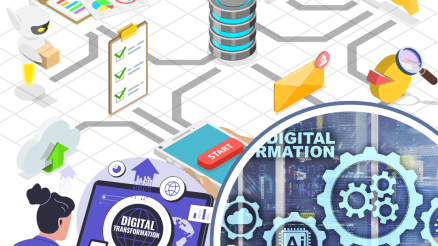Ever imagined getting healthcare at home with smart tech helping doctors make better decisions?
Digital transformation is making it happen.
Digital transformation in healthcare is changing how we approach medicine, patient care, and healthcare management.
It uses technology to improve efficiency, accuracy, and patient experiences.
From electronic health records to telemedicine, the healthcare industry is evolving rapidly.
In this article, we will explore why digital transformation is so important for healthcare and how it is reshaping the industry.
Improving Patient Care with Technology
Technology is playing a big role in improving patient care by making healthcare faster, more accurate, and easier to access.
Doctors now have digital tools that help them make better decisions and offer more personalized care to patients.
Wearable devices, like smart watches, track important health data such as heart rate, sleep, and physical activity. These devices can alert doctors to any concerning changes in a patient’s health, helping them intervene early.
Artificial intelligence (AI) is also helping doctors analyze medical images and predict health issues, allowing for earlier and more accurate diagnoses.
The Role of Electronic Health Records (EHR)
Electronic Health Records (EHR) are changing the way doctors and patients manage health information.
Instead of keeping paper files, everything is stored digitally, which makes it easier for doctors to access a patient’s medical history quickly and accurately.
When a patient visits a new doctor, they no longer need to bring a stack of paperwork or worry about missing details. With EHRs, doctors can instantly see past treatments, allergies, and medications.
A large healthcare network reported a 40% decrease in medication errors after implementing digital prescriptions and EHR systems.
EHRs also make it easier for doctors to share information with specialists, ensuring a more coordinated approach to care.
Telemedicine: Healthcare from a Distance
If someone has a common health concern or needs a follow-up checkup, they can speak to their doctor without leaving their house.
Telemedicine is changing the way we receive healthcare by allowing patients to consult with doctors remotely, from the comfort of their own homes.
Instead of traveling to a clinic or hospital, patients can now use their phones, computers, or tablets to have a video call with their doctor. This makes healthcare more accessible for people who live in rural areas or have mobility issues.
It saves time, reduces stress, and makes it easier to get advice without waiting for an in-person appointment.
Telemedicine also helps reduce the spread of infections by allowing people to stay at home when they’re feeling unwell.
Plus, telemedicine is not just about convenience—it’s also about better care. It helps doctors and patients stay connected, even when they can’t be in the same room.
In 2022, major Hospital saw a 30% reduction in patient wait times after implementing telemedicine platforms.
Enhancing Operational Efficiency in Healthcare
Digital systems are helping hospitals and clinics run more smoothly and efficiently. These systems make everything faster, more organized, and less prone to errors.
For example, hospital management software can help track patient appointments, medical records, and staff schedules all in one place. This means that doctors, nurses, and administrators don’t waste time searching for information—they can find what they need quickly.
Inventory management systems are also making a big difference. Hospitals need many supplies, like medicines, equipment, and surgical tools.
Digital systems help keep track of what’s in stock, so nothing gets lost or runs out. If a certain item is low, the system automatically alerts staff to order more. This keeps things running smoothly without disruptions.
In the past, billing could be slow and confusing. Now, digital systems can process insurance claims and payments quickly and accurately. This reduces mistakes and saves time for both patients and healthcare staff.
By using digital tools, healthcare providers can spend more time focusing on what really matters—taking care of patients. These systems help reduce administrative burdens, improve communication and allowing hospitals to provide better care for everyone.
Data Security and Privacy in Healthcare
In today’s digital world, protecting patient information is more important than ever. With all the medical records, test results, and personal details stored online, it’s crucial to make sure that this sensitive data is safe from hackers.
Healthcare organizations use strong security systems to keep patient information private and secure. These systems include things like encryption, which turns data into unreadable code, and firewalls that block unwanted visitors.
Doctors and hospitals also train their staff to follow strict privacy rules. They only share information with the right people—like other doctors or specialists who are involved in a patient’s care. This ensures that patient details are kept confidential.
Many healthcare organizations also use two-factor authentication. This means that in addition to a password, users need to verify their identity in another way, like through a code sent to their phone.
Patients can also play a role in protecting their own privacy by choosing strong passwords for their online health accounts and being careful about what personal details they share online.
Protecting patient data is a top priority in healthcare. With proper security measures, providers ensure that health information remains safe and confidential.
Challenges and Opportunities of Digital Transformation
Digital transformation is crucial for the future of healthcare, but it does come with its challenges.
One challenge is the cost of implementing new technologies. Hospitals and healthcare providers need to invest in systems like electronic health records (EHR), telemedicine, and other digital tools. This can be expensive, especially for smaller healthcare centers.
Another challenge is training healthcare professionals to use new technologies. While the tools are designed to make healthcare more efficient, they can be difficult to use without proper training.
Data security is a key concern as healthcare moves into the digital space. Protecting patient data from cyber threats is essential for maintaining trust and privacy. The good news is that digital transformation brings advanced security measures like encryption and authentication protocols, which help secure sensitive information, making it safer for both patients and healthcare providers.
The opportunities, however, are enormous. Digital transformation can lead to improved patient care through tools like telemedicine and wearable devices. These tools enable healthcare professionals to monitor patients remotely. With digital systems in place, healthcare can be more accessible, even for those in remote or underserved areas.
By automating and streamlining administrative tasks like billing, scheduling, and record-keeping, healthcare professionals can focus more on patients and less on paperwork. This increases efficiency and reduces errors, making healthcare systems smoother and more patient-centered.
Final words
Digital transformation in healthcare improves patient care and efficiency. Training staff to use new digital tools is crucial. Keeping patient data secure builds trust. Telemedicine and wearables allow remote care, while automation reduces errors and saves time. Digital tools make healthcare more accessible, especially in remote areas. Overall, digital transformation is key for a better, more efficient healthcare system.



